Filipino Sign Language
Last updated| Filipino Sign Language | |
|---|---|
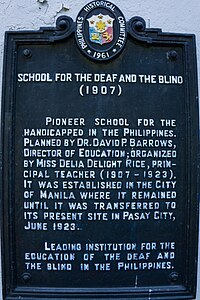 | |
| Native to | Philippines |
Native speakers | 121,000 (2008) to est. 325,000–650,000 (2021) [1] |
French Sign
| |
| Language codes | |
| ISO 639-3 | psp |
| Glottolog | phil1239 |
Filipino Sign Language (FSL) or Philippine Sign Language (Filipino : Wikang pasenyas ng mga Pilipino), [2] is a sign language originating in the Philippines. Like other sign languages, FSL is a unique language with its own grammar, syntax and morphology; it is neither based on nor resembles Filipino or English. [3] Some researchers consider the indigenous signs of FSL to be at risk of being lost due to the increasing influence of American Sign Language. [3]
Contents
The Republic Act 11106 or The Filipino Sign Language Act, effective November 27, 2018, declared FSL as the national sign language of the Filipino Deaf. [4]
ASL influence
FSL is believed to be part of the French Sign Language family. [5] It has been strongly influenced by American Sign Language since the establishment in 1907 of the School for the Deaf and Blind (SDB) (now the Philippine School for the Deaf) by Delia Delight Rice (1883–1964), an American Thomasite teacher born to deaf parents. [6] The school was run and managed by American principals until the 1940s. In the 1960s, contact with American Sign Language continued through the launching of the Deaf Evangelistic Alliance Foundation and the Laguna Christian College for the Deaf. Another source of ASL influence was the assignment of volunteers from the United States Peace Corps, who were stationed at various places in the Philippines from 1974 through 1989, as well as religious organizations that promoted ASL and Manually Coded English. [7] Starting in 1982, the International Deaf Education Association (IDEA), led by former Peace Corps volunteer G. Dennis Drake, established a series of residential elementary programs in Bohol using Philippine Sign Language as the primary language of instruction. [8] [9] The Bohol Deaf Academy also primarily emphasizes Philippine Sign Language. [10]
According to sign language researcher Dr. Lisa Martinez, FSL and ASL deviate across three important metrics: different overall form (especially a differing handshape inventory), different methods of sign formation, and different grammar. [3]
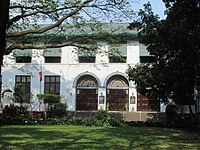
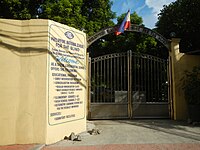
Status
Usage of Filipino Sign Language was reported in 2009 as being used by 54% of sign-language users in the Philippines. [11] In 2011, the Department of Education declared Signing Exact English the language of deaf education in the Philippines. [12] In 2011, Department of Education officials announced in a forum that hearing-impaired children were being taught and would continue to be taught using Signing Exact English (SEE) instead of Filipino Sign Language (FSL). [13] In 2012, House Bill No. 450 was introduced in the Philippine House of Representatives by Rep. Antonio Tinio (Party-list, ACT Teachers) to declare FSL as the National Sign Language of the Philippines and to mandate its use as the medium of official communication in all transactions involving the deaf and the language of instruction of deaf education. [12] As of May 2014 [update] , that bill was pending with the Committee on Social Services. [14]
In September 2018, Senate Bill No. 1455, sponsored by Senators Nancy Binay, Sherwin Gatchalian, Chiz Escudero, Bam Aquino, Loren Legarda, Joel Villanueva, Cynthia Villar, and Juan Miguel Zubiri, passed on third and final reading.
On October 30, 2018, Republic Act 11106 or The Filipino Sign Language Act was signed into law by President Rodrigo Duterte declaring the Filipino Sign Language as the national sign language of the Filipino Deaf. The law also declares the country's national sign language as the official sign language of the government in all transactions involving the deaf. [15]
The law, which seeks to eliminate all forms of discrimination against the Filipino Deaf, also mandates the use of the Filipino Sign Language in schools, broadcast media, and workplaces. It also mandates the Komisyon sa Wikang Filipino, in consultation with the stakeholders, to establish a national system of standards and procedures for the interpretation of the Filipino Sign Language. The University of the Philippines System and other education agencies are tasked to develop guidelines for the development of training materials in the education of the Deaf. The law also require the availability of qualified sign language interpreters in all hearings, proceedings, and government transactions involving the Deaf. [16]
"The FSL shall be recognized, promoted and supported as the medium of official communication in all transactions involving the deaf, and as the language of instruction of deaf education, without prejudice to the use of other forms of communications depending on individual choice or preference," the law states. The Department of Education (DepEd), Commission on Higher Education (CHEd), Technical Education and Skills Development Authority (Tesda), and all other national and local government agencies involved in the education of the deaf, are tasked to use and coordinate with each other on the use of FSL as the medium of instruction in deaf education. [17]
The law became effective on November 27, 2018 [15] while its implementing rules and regulations was approved in 2021. [18]
See also
Related Research Articles

Filipino is a language under the Austronesian language family. It is the national language of the Philippines, and one of the two official languages of the country, with English. It is a standardized variety of Tagalog based on the native dialect, spoken and written, in Metro Manila, the National Capital Region, and in other urban centers of the archipelago. The 1987 Constitution mandates that Filipino be further enriched and developed by the other languages of the Philippines. Filipino is only used as a tertiary language in the Philippine public sphere.
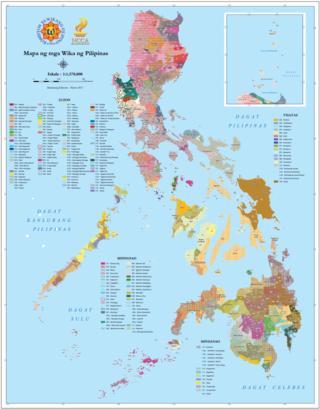
There are some 130 to 195 languages spoken in the Philippines, depending on the method of classification. Almost all are Malayo-Polynesian languages native to the archipelago. A number of Spanish-influenced creole varieties generally called Chavacano along with some local varieties of Chinese are also spoken in certain communities. The 1987 constitution designates Filipino, a standardized version of Tagalog, as the national language and an official language along with English. Filipino is regulated by Commission on the Filipino Language and serves as a lingua franca used by Filipinos of various ethnolinguistic backgrounds.

The Commission on Higher Education is a government agency under the Office of the President of the Philippines. It is responsible for regulating and governing all higher education institutions and post-secondary educational programs in the country.
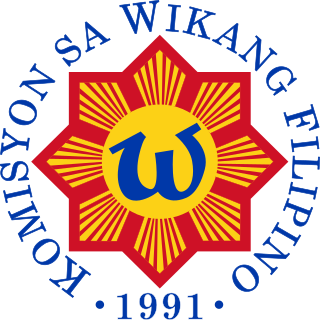
The Commission on the Filipino Language (CFL), also referred to as the Komisyon sa Wikang Filipino (KWF), is the official regulating body of the Filipino language and the official government institution tasked with developing, preserving, and promoting the various local Philippine languages. The commission was established in accordance with the 1987 Constitution of the Philippines.
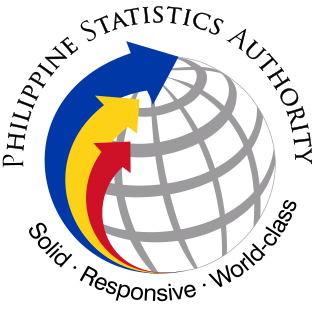
The Philippine Statistics Authority is the central statistical authority of the Philippine government that collects, compiles, analyzes and publishes statistical information on economic, social, demographic, political affairs and general affairs of the people of the Philippines and enforces the civil registration functions in the country.
The legal recognition of signed languages differs widely. In some jurisdictions, a signed language is recognised as an official language; in others, it has a protected status in certain areas. Although a government may stipulate in its constitution that a "signed language" is recognised, it may fail to specify which signed language; several different signed languages may be commonly used.

The National Intelligence Coordinating Agency (NICA) is the primary intelligence gathering and analysis arm of the Government of the Philippines in charge of carrying out overt, covert, and clandestine intelligence activities. The NICA directs, coordinates, and integrates all intelligence activities, both foreign and domestic, concerning national security, serving as the leading intelligence collector of the national government, focusing on the country's strategic intelligence requirements. It is mandated to prepare intelligence estimate on local and foreign situation for the formulation of national security policies by the President and the National Security Council.
Education in the Philippines is compulsory at the basic education level and is grouped into three levels: kindergarten, elementary school, junior high school, and senior high school. The educational system is managed by three government agencies by level of education: the Department of Education (DepEd) for basic education; the Commission on Higher Education (CHED) for higher education; and the Technical Education and Skills Development Authority (TESDA) for technical and vocational education. Public education is funded by the national government.

Rodrigo Roa Duterte, also known as Digong, Rody, and by the initials DU30 and PRRD, is a Filipino lawyer and politician who served as the 16th president of the Philippines from 2016 to 2022. He is the chairperson of PDP–Laban, the ruling political party in the Philippines during his presidency. Duterte is the first president of the Philippines to be from Mindanao, and is the oldest person to assume office, beginning his term at age 71.
Imperial Manila is a pejorative epithet used by sectors of Filipino society and non-Manileños to express the idea that all the affairs of the Philippines, whether in politics, economy and business or culture, are decided by what goes on in the capital region, Metro Manila without considering the needs of the rest of the country, largely because of centralized government and urbanite snobbery. Empirical research finds that Imperial Manila and its persistence over time has led to prolonged underdevelopment in Philippine provinces.

The Philippine Federation of the Deaf, Inc. (PFD) is a non-stock, non-profit organization which caters to the general needs of deaf people in the Philippines.
The national symbols of the Philippines consist of symbols that represent Philippine traditions and ideals and convey the principles of sovereignty and national solidarity of the Filipino people. Some of these symbols namely the national flag, the Great Seal, the coat of arms and the national motto are stated in the Flag and Heraldic Code of the Philippines, which is also known as Republic Act 8491. In the Constitution of the Philippines, the Filipino language is stated as the national language of the Philippines. Aside from those stated symbols in the Constitution and in Republic Act 8491, there are only six official national symbols of the Philippines enacted through law, namely sampaguita as national flower, narra as national tree, the Philippine eagle as national bird, Philippine pearl as national gem, arnis as national martial art and sport and the Filipino Sign Language as the national sign language. Thus, there is a total of twelve official national symbols passed through Philippine laws.

The Philippine Space Agency (PhilSA) is the national space agency of the Philippines.
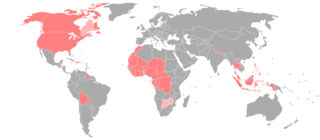
American Sign Language (ASL) developed in the United States and Canada, but has spread around the world. Local varieties have developed in many countries, but there is little research on which should be considered dialects of ASL and which have diverged to the point of being distinct languages.
2017 in the Philippines details events of note that happened in the Philippines in 2017.
The following are the events in related to Philippine law in 2016. This includes developments in criminal investigations of national notability.

Rodrigo Duterte became the 16th President of the Philippines on June 30, 2016, succeeding Benigno Aquino III. He was the first president from Mindanao, the first president to have worked in all three branches of government, and the oldest to be elected. He won the election amid growing frustration with post-EDSA governance that favored elites over ordinary Filipinos. His tenure ended on June 30, 2022.

The Philippine Charity Sweepstakes Office is a government-owned and controlled corporation of the Philippines under direct supervision of the Office of the President of the Philippines. It is mandated to do fund raising and provide funds for health programs, medical assistance and services, and charities of national character. The raised collections goes to the President's Presidential Social Fund to improve the country's social welfare.
The Filipino Sign Language (FSL) is the official language of education for deaf Filipinos, which number around 121,000 as of 2000.
References
- ↑ Filipino Sign Language at Ethnologue (25th ed., 2022)

- ↑ Hammarström, Harald; Forke, Robert; Haspelmath, Martin; Bank, Sebastian, eds. (2020). "Philippine Sign Language". Glottolog 4.3.
- 1 2 3 Martinez, PhD, Liza (December 1, 2012). "Primer on Filipino Sign Language". Philippine Daily Inquirer. Retrieved February 9, 2017.
- ↑ "PRRD inks Filipino Sign Language Act into law". Philippine News Agency . November 12, 2018. Retrieved November 29, 2018.
- ↑ Wittmann, Henri (1991). "Classification linguistique des langues signées non vocalement." Revue québécoise de linguistique théorique et appliquée 10:1.215–88.
- ↑ A century of absolute commitment – The Manila Times Internet Edition (archived from the original on February 25, 2007)
- ↑ Abat, Rafaelito M., and Liza B. Martinez. The History of Sign Language in the Philippines: Piecing Together the Puzzle, Philippine Federation of the Deaf / Philippine Deaf Resource Center, Philippine Linguistics Congress, Department of Linguistics, University of the Philippines, January 25–27, 2006, 8 pages (PDF), retrieved on: March 25, 2008 (archived from the original [ permanent dead link ] on July 28, 2011)
- ↑ Education, July 17, 2012, International Deaf Education Association, retrieved on August 25, 2014.
- ↑ The Founder And History, August 16, 2012, International Deaf Education Association, retrieved on August 25, 2014.
- ↑ Academics, Bohol Deaf Academy, retrieved on August 25, 2014.
- ↑ Calls made for a national language for the deaf – The Carillon (archived from the original on March 25, 2012)
- 1 2 House Bill No. 450 : Explanatory Note, Congress of the Philippines, July 1, 2013.
- ↑ The right of the deaf to their language, Philippine Daily Inquirer, September 16, 2011.
- ↑ Hon. Tinio, Antonio L : HOUSE MEASURES SPONSORED/AUTHORED, Retrieved on May 29, 2014.
- 1 2 An Act Declaring The Filipino Sign Language as the National Sign Language of the Filipino Deaf and the Official Sign Language of Government in All Transactions involving the Deaf, and Mandating its use in Schools, Broadcast Media and Workplaces – The Philippine Official Gazette
- ↑ Duterte Signs Filipino Sign Language Into Law – ABS-CBN News
- ↑ Duterte Signs Filipino Sign Language Act – Inquirer News
- ↑ Cervantes, Filane Mikee (December 9, 2021). "House leader hails approval of IRR of Filipino Sign Language law". Philippine Canadian Inquirer. Philippine News Agency. Retrieved December 9, 2021.
External links
-
 Media related to Philippine Sign Language at Wikimedia Commons
Media related to Philippine Sign Language at Wikimedia Commons
Bibliography
- Video
- Mi Ultimo Adios in Filipino Sign Language [1]
- Philippine National Anthem in Filipino Sign Language [2]
- Silent Odyssey: A Journey into the Deaf World [3]
- Filipino Sign Language GMANews TV Documentary [4]
- Text
- An Introduction to Filipino Sign Language (PDRC/PFD, 2004)
- Filipino Sign Language: A Compilation of Signs from Regions of the Philippines (PFD, 2005)
- Status Report on the Use of Sign Language in the Philippines (NSLC)
- Filipino Sign Language (PEN International, DLS-College of St. Benilde) downloadable PDF
- Republic Act 11106 downloadable PDF
- ↑ First Ever Filipino Sign Language Interpretation of Rizal's Poem – Mirana Medina, Filmmaker
- ↑ Philippine National Anthem in Sign Language – Planet Eye Traveler
- ↑ Filipino Filmmaker Showcases Deaf Community – Mirana Medina, Filmmaker
- ↑ Filipino Sign Language (in Filipino), GMANews TV Documentary Report
Text is available under the CC BY-SA 4.0 license; additional terms may apply.
Images, videos and audio are available under their respective licenses.
